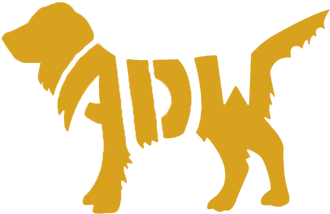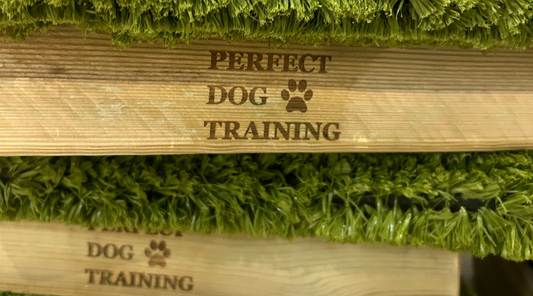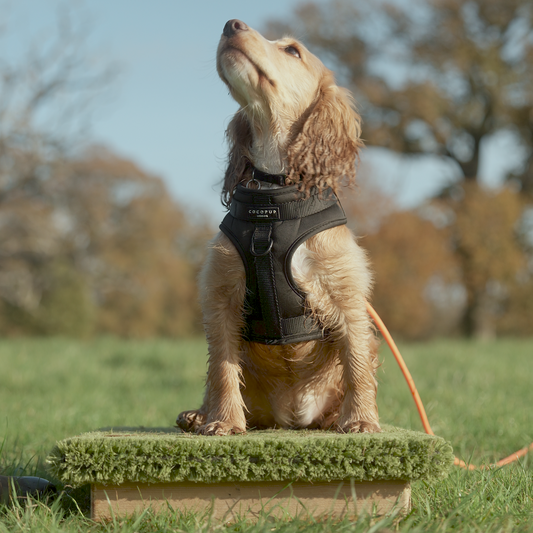Learn more about Place Boards for dogs and their use in training.
What are Place Boards?
- ‘Place boards’ are a rectangular stable raised platform, with a non-slip textured top, which contrasts with the surrounding surface that can be used indoors or outdoors in a range of dog training exercises as a target. The rectangular shape defines the direction the dog faces when interacting with the target and the handler, allowing directional cues and behaviours to be taught.
In gundog circles, traditionally artificial grass is used as the non-slip surface, which you can see on the Place Boards our shop has for sale.


Why Use a Place Board in Dog Training?
- The place boards elevated height and contrasting surface make it feel a very different place to be for the dog than the surrounding area during training.
- When we introduce place boards in foundational training it allows the dog to build positive associations with the board; we can then use them in our training as a way for us handlers to communicate to the dog the desired behaviour.
- This type of target training has been made popular in dog training by professionals such as field trial champion Ian Openshaw when he demonstrated the merit of using boards as gundog training equipment in place board training for spaniels at the CLA Game Fair.
How would I phase out the place board from dog training?
- Place boards are used in training to set the dog up for success as they are used as a tool to communicate our expectations to the dog.
- Lots of successful repetitions using the platform as a target allow your dog to rehearse the correct behaviour.
- Responding to our cues in these successful repetitions strengthens the dogs' neural pathway making the decision for the dog to offer the behaviour we are training more 'default'.
- When you phase place boards out of your training, you give the dog the same cue, asking for the same behaviour we have practised with place board training. The difference is, this time there is no place board to target, but they're more likely to succeed because of the large number of successful repetitions strengthening their response to the cue.
How big should a place board be?
- The tops are made of sturdy OSB board and our dog training place boards dimensions measure the industry standard: Metric, 61cm x 38cm/ Imperial, 24” x 15”, the size of place boards for dog training comfortably seats all breeds.
-
FAQ: Will a 40 x 60cm Place Board fit my breed?
 A: Yep, it works for even the biggest Dobbie butt!
A: Yep, it works for even the biggest Dobbie butt!
In class, we meet lots of large dogs, and the dimensions have worked for them. The narrow fit is actually useful when a tidy sit or precise movement is required (read more below).

Why Place Boards must be rectangular
- The shape encourages careful paw placement and dictates the direction the dog faces, which can benefit exercises such as straight sits by your side in obedience.
- In gundog training, a straight sit ensures that your dog is watching the same area as you when retrieves fall, and is lined up at the correct angle when sent; even a slight deviation on a long retrieve and the dog could run well of course from where you wanted to send them.

Below is a Large (32kg) Shepherd on one of our Place Boards demonstrating these dimensions comfortable fit all breeds.
Why are the boards raised?
- Being raised off the ground helps dogs spot and target their board from a distance.
Why are the place boards topped in artificial grass?
- The texture of the mat on top provides a tactile contrast to the surrounding surface so there will be a perceptible difference to the dog having all four paws in the right place versus offering the wrong position.
- For example: when practising sit & stay we can teach the dog that when they place all four paws on the boards is when they earn a reward, whereas if they step off or creep forward, they will not earn a treat, so the dog will be less likely to offer incorrect behaviour in the future.
- The grass is a non-slip surface which encourages the dog to target the board with drive. If it did not have a suitable covering or sturdy base it may slip during training which could cause a dog to lose confidence.
Do you have to use a place board to teach ‘place’?
- There are benefits to using a place board outlined in the questions above such as its sturdy raised platform, dimensions, and non-slip surface.
- However, if you decide to place a mat on the ground instead, put it away when not training and make sure it has similar properties to our artificial grass e.g. non-slip (check out 'Why are the place boards topped in artificial grass?')
Why can't you use a dog's bed to teach 'Place' instead?
- It is not recommended. Using sit-stay as an example: if you are teaching ‘place’ means sit in their bed, when in ‘training mode’ your expectations are likely to be for dog to remain in position on the bed until released and the dog will be receiving food rewards while they sit.
- But then out of training mode and returning to ‘everyday life’ it is likely our expectations change; the dog has free access to their bed, being allowed to go in and out of the bed without any treats or cues.
- When the dog goes into their bed and no treats are produced, you can undo positive association work you have been building in training so progress will be slower.
What age can you start place board training?
- Place boards can be used in puppy training, so introduce them to your training right away!
- Below, a 13 week old puppy using a Place Board in a 121 to learn the foundations of her sit-stay; in just one session she was able to sit for 30 seconds as her owner took steps away, what a good girl!

How are they used in advanced place board training?
- The boards can teach the dog where they need to be in relation to the handler. For example: To teach a dog that recalls means come right back to the handler and avoid a dog that returns but dances just out of reach, you can put a place board by your feet paired with calling your dog back to you. Now they are running back to a target right in front of you.
Read our articles on Place Board Training by clicking here
How are Anglian Dog Works boards an Eco-Conscious Dog Product?
- It is Anglian Dog Works’ ethos to make environmentally conscious and responsible choices when we choose materials; in line with our business’ values, therefore all dog training place boards for sale are constructed predominantly with renewable and recycled materials.
- Professional venues and events lift nearly new artificial grass often after a single use or a set number of years for insurance purposes. Due to the difficultly in separating the material into raw components, after use, artificial grass is usually destined for landfill. Collaborating with a local tradesperson Anglian Dog Works have been able to develop a unique reconditioning process so that instead the artificial grass starts a new life as the recycled surface on the boards.
Why buy from Anglian Dog Works?

- The design and build team includes a professional dog trainer who is a member with the distinction of the Institute of Modern Dog Trainers (IMDT). With extensive first-hand experience of using place boards for dog training in classes, and training their own dogs, the specifications of Anglian Dog Works’ place boards are well thought out and you can be assured of a quality product.
Buy a Place Board






